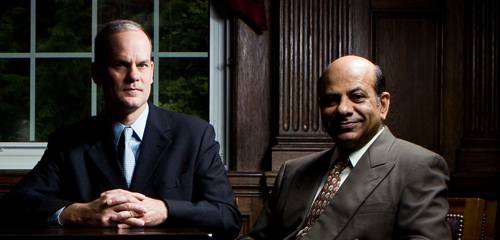Beyond the Big Idea
In The Other Side of Innovation, Tuck faculty members Vijay Govindarajan and Chris Trimble offer organizations a model for making innovation happen.

The brilliance of Thomas Edison’s landmark invention has become so ingrained in public consciousness that a lightbulb pops up above cartoon characters’ heads whenever they have a bright idea. Never mind that Edison’s contributions to incandescent light built on the work of many others, or that he led a large industrial research team. People seem to prefer the myth that the lightbulb was one man’s stroke of genius.
A new book about carrying out big ideas, by Tuck faculty members Vijay Govindarajan and Chris Trimble, takes on that misconception and uses the inventor’s words of caution inside the cover: “Genius is 1 percent inspiration, 99 percent perspiration.” The Other Side of Innovation: Solving the Execution Challenge (Harvard Business Press, September 2010) is about the latter. The book builds on the pair’s 2005 international best-seller, 10 Rules for Strategic Innovators: From Idea to Execution (Harvard Business Press). But while that work dealt with high-risk, high-growth examples, Govindarajan and Trimble have broadened their focus to include any new product, new service, move into a new market, or new technology. In short, anything that is new to the company, and thus uncertain. “When companies get excited about innovation, what they inevitably do is put a lot of energy into the process of looking for a breakthrough idea,” explains Trimble. “What happens next—trying to make innovation happen inside an organization—is where companies are much more in need of advice.”
The problem with implementing any new initiative is that organizations are actually structured to discourage innovation. Successful companies are dedicated to running existing operations, and they do this by making every task as repeatable and as predictable as possible. “All that’s very good for day-to-day efficiency,” Trimble points out, “but repeatable and predictable is exactly the opposite of the reality of any innovation.”
Using detailed case studies collected from dozens of companies—including 3M, Cisco, IBM, Hasbro, and Wal-Mart—the book brings to life the challenges of innovating within a company. The writers had their own “a-ha” moment during a meeting with a client at a Fortune 500 company. Discussing the formation of a special group to execute a new growth strategy, they made the offhand suggestion to call the group “the innovation team.” The client rolled his eyes and disdainfully asked what this team would do. “Brainstorm? Sit around being creative all day? Talk condescendingly about a superior organizational culture?” Govindarajan and Trimble soon discovered the same animosity within innovation teams toward the people running the day-to-day operations, expressed in words like “bureaucratic,” “robotic,” “rigid,” and “dull.”
With this in mind, they spend much of their latest book outlining a model for running a disciplined innovation experiment and then offer guidelines on how to evaluate its success. Companies trying to encourage innovation generally rely on one of two strategies: “innovation is everybody’s job every day” or the dreaded innovation team. “The model we propose in the book is an internal partnership between a dedicated team that focuses full time on an innovation initiative, and the established organization,” explains Trimble. “The fundamental message is that you need a partnership. You can’t make innovation everybody’s job every day and expect anything big. Nor can you say that innovation is the special domain of only a small subset of people out in the skunk works. It is really tough to make this partnership work, but it is absolutely essential and it can be done.”
What most surprised the authors since broadening their scope in 2005 was how this general organizational model could be applied over a wide range of initiatives. “When we launched our effort to do this, we anticipated writing a lot of ‘if ... then’ recommendations,” adds Govindarajan. “But what we found was that the general was more powerful than the specific. We didn’t expect to see that, and seeing it, in fact, was a pretty hard-won victory.”